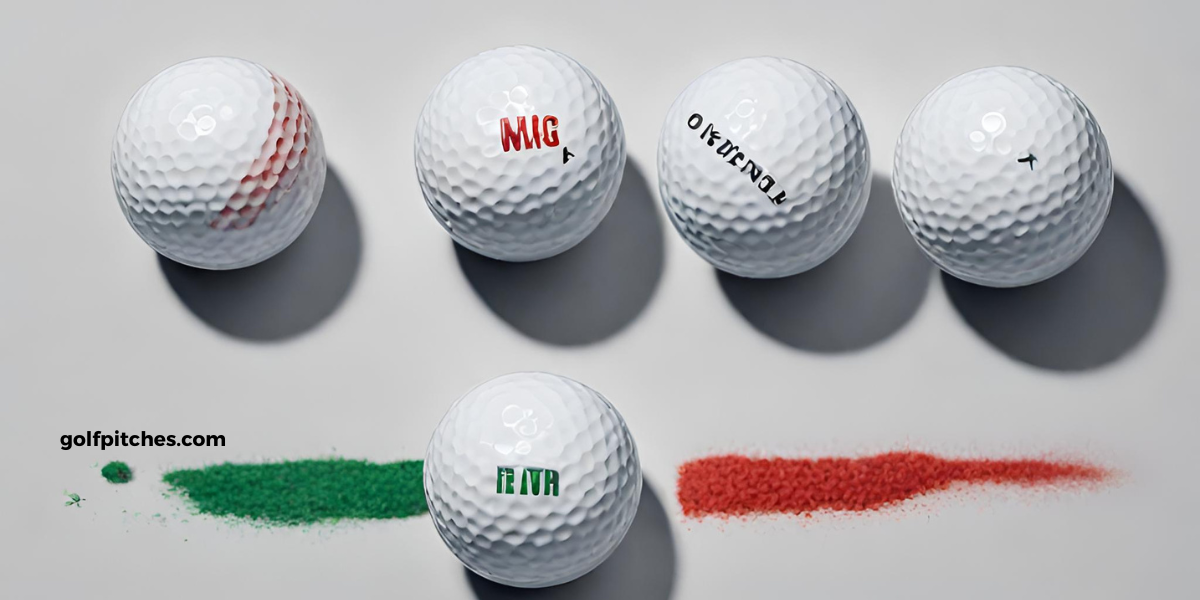7 Cool Ways to Mark Your Golf Ball


One of the most overlooked aspects of golf that can actually make a big difference in your game is how you mark your golf ball. You may not be a pro golfer, but that doesn’t mean you can’t look and feel like one, starting with your golf balls.
Marking your golf ball is not only essential for identifying it during a game but also an opportunity to add a unique touch. In this guide, we’ll dive deep into cool ways to mark your golf balls, from simple dots to intricate designs inspired by the pros.
You can always go for the classics, like:
- Initials: Just use a permanent marker to put your initials on the ball. Simple, yet effective.
- Single Dot: Placing a single dot on your ball is minimalist but can be effective for quick identification. Tiger Woods, for example, used to mark his ball with a simple dot.
Cool Ways to Mark Your Golf Balls
Now, let’s get into the main course: cool ways to mark your golf balls that not only set you apart but might even improve your game.
Using Geometric Shapes

If you’re into geometry, you can use a combination of circles, squares, and triangles to create unique patterns. Make sure the shapes are symmetrical for a balanced look.
Geometric designs have a symmetrical and visually pleasing aspect that can make your golf ball stand out, not just to you but to anyone who sees it. They add an artistic element to the game that can be both fun and engaging.
The combinations you can create with geometric shapes are endless. You can stick to a single shape, like a triangle, for simplicity, or combine multiple shapes for a more intricate design. You can also vary the size and color of the shapes based on your preferences.
If used strategically, geometric shapes can also act as visual alignment aids, similar to how some professionals use lines on their golf balls for putting. For example, an arrow or a straight line in conjunction with circles can help you line up your shots more accurately.
Using Emoji Stamps

Yes, you can actually buy emoji stamps designed specifically for golf balls. Want to smile every time you putt? Stamp a smiley face on there!
Emoji stamps allow for personal expression on the golf course, which is something the game can sometimes lack when everyone is in similar golf attire and using similar equipment.
Want to convey your love for the game? Stamp a heart emoji on your ball. Feeling lucky? The four-leaf clover or horseshoe emojis might be your go-to symbols. The options are as diverse as emojis themselves.
A bright, easily recognizable emoji can make it quicker to identify your ball in the rough or among other balls. This adds a layer of functionality to the choice of using an emoji stamp.
By marking your golf balls with emoji stamps, you’re not just adding a unique identifier to your equipment; you’re also injecting a bit of contemporary culture into an age-old game. And that’s what makes it one of the coolest ways to mark your golf balls.
Pay Tribute to the Legends
Marking your golf ball with a tribute to a legend is more than just a visual identifier—it’s a powerful statement. It’s an homage to the greats, a motivational tool, and an incredible conversation starter.
You could mark your ball with a “TW” for Tiger Woods or “AP” for Arnold Palmer.
Having the name or initials of a golf legend on your ball can serve as a mini pep talk. Say you’re faced with a difficult putt; glancing down and seeing the initials “BH” for Ben Hogan—a man known for his legendary focus and work ethic—might just give you the mental edge you need.
The “Tribute to Legends” method of marking your golf ball is more than cool; it’s inspirational, rich in historical significance, and personal. It encapsulates what you love about the game, offering both a visual and emotional edge every time you step onto the course.
Using UV Markers

UV markers are swiftly climbing up the popularity ladder when it comes to cool ways to mark your golf balls, and for a litany of excellent reasons.
To start with, UV Markers are incredibly cool. They glow in the dark! Imagine stepping onto the course as the sun sets, your golf ball glowing like a beacon, guiding you through your game. Not only does it add an extra layer of fun, but it’s also a brilliant way to easily identify your golf ball in low-light conditions.
UV Markers contain a special type of ink that’s sensitive to ultraviolet light. When you shine a UV flashlight on the marked ball, it glows.
One of the critical questions any golfer might have is, “Will it affect my ball’s performance?” The answer is no. UV markers are designed to be lightweight and nonintrusive, meaning they won’t alter the aerodynamics of your ball. You can putt, chip, and drive to your heart’s content!
Pros and Cons of Using UV Markers
Pros:
- Visibility: These markers enhance visibility, making it easier to locate your ball in dim lighting.
- Fun Factor: Let’s face it, a glowing golf ball is fun and adds a unique twist to the game.
- Personalization: You can use different colors to create your own glowing designs, making your ball distinctively yours.
Cons:
- Limited to Night Golf: Obviously, the glow factor is relevant only in dark settings.
- Requires UV Flashlight: You will need to carry a UV flashlight to activate the glow, which could be cumbersome for some.
Using Zodiac Signs

The idea of using Zodiac signs as a way to mark your golf balls isn’t just innovative; it’s also a fascinating merger of two worlds—astrology and golf—that you wouldn’t normally associate with each other.
But think about it: Both golf and astrology are deeply personal pursuits that many people feel an emotional connection to.
The first thing that makes using Zodiac signs a cool way to mark your golf balls is the personal connection. Each Zodiac sign has its unique attributes and qualities.
- Are you a Capricorn? Perhaps your disciplined approach to golf mirrors your astrological traits.
- Or maybe you’re a free-spirited Sagittarius who loves the adventure of trying new courses.
Marking your golf balls with your Zodiac sign adds a level of personalized engagement to your game that few other markings can.
Your Zodiac sign is believed to reflect certain character traits and tendencies. So why not apply that to your golf game? If you’re a Virgo, known for attention to detail, you might find it easier to focus on your short game.
Colorful Dots
Grab markers in multiple colors and add dots around the ball number or logo. Not only are these easy to identify, but they can also aid in alignment.
Example: Justin Thomas uses a blue mark next to the number on his golf ball.
- Use High-Quality Markers: Choose markers that are waterproof and won’t easily fade.
- Practice on Old Balls: Before marking a new set of balls, practice your design on some old ones.
- Allow Time for Drying: Give the ink ample time to dry to prevent smudging.
- Test Before Play: Test to ensure the markings don’t affect your play or violate any rules.
Marking Balls With Your Signature

A signature is more than just a name; it’s an extension of your personality and a stamp of your individuality.
Your signature is your own. It’s one-of-a-kind and distinctive, just like a fingerprint. This level of uniqueness adds an exclusive touch to your golf game. You’re not just another golfer on the course; you’re the golfer with the unmistakable trademark on your ball.
Crafting a mini version of your signature on your golf ball may require some practice and a steady hand, but the precision involved adds an extra layer of engagement to your preparation. This attention to detail can translate into a more focused approach in your game.
What Materials Can I Use to Mark Golf Balls?
When it comes to marking your golf ball, not all materials are created equal. The choice of material not only influences the durability of the marking but also the speed with which you can apply it.
From traditional ink markers to specialized golf ball stencils, your options are more varied than you might think. Let’s delve into the different materials you can use to effectively mark your ball and make it distinctively yours.

Permanent Ink Markers
Arguably the most popular and readily available, permanent ink markers like Sharpies offer a quick and inexpensive way to mark your ball.
The benefits are obvious: they’re waterproof, come in various colors, and the markings last for several rounds. Choose ultra-fine tips for detailed designs or broader tips for larger markings.
Pro Tip: Make sure the ink is fully dry before playing to avoid smudging. A minute or two is usually sufficient.

Golf Ball Stamps
These are rubber stamps specifically designed for golf balls, coming with quick-dry, waterproof ink. They are perfect for applying predefined shapes or logos uniformly on multiple balls. The advantage is speed and consistency, but the designs are generally not customizable.
Expert Insight: Look for golf ball stamps that use non-toxic ink to ensure they won’t interfere with the ball’s performance.
Acrylic Paint
For the artists among us, acrylic paint offers a way to turn your golf ball into a miniature canvas. Using a fine brush, you can create detailed designs or even miniature artwork. However, be aware that the paint can chip off over time, especially during play.
Did You Know?: Acrylic paint markings may last longer if you apply a clear sealant spray after the paint has dried.
Golf Ball Stencils
These are plastic or metal guides that fit around your golf ball, allowing you to mark it consistently with ink or paint. Often they come in sets with various designs, like arrows for alignment or initials for identification.
Insider Information: Many professionals use stencils to create perfect alignment marks, which aids in putting accuracy.
Online platforms like Amazon, eBay, and dedicated golf stores such as Golf Galaxy and Rock Bottom Golf provide catalogs of different golf markers.
On these online stores, you can find specialized markers that range from traditional ink markers to UV-protected and waterproof markers.
One product that’s garnered attention is the Golf-EZ Golf Ball Marker system, which comes with a variety of stencil designs and long-lasting ink.
However, before buying a golf marker, it’s advisable to check product reviews on YouTube or specialized golf forums.
Expert golfers often review the durability, ease of use, and quality of the markings, which can help you make an informed decision.
Is it Necessary to Mark My Golf Ball?

When it comes to the game of golf, small details can have a significant impact, and marking your golf ball is one such detail that’s often overlooked by beginners but embraced by seasoned players.
The short answer to the question, “Is it necessary to mark my golf ball?” is both yes and no. It depends on the context in which you’re playing, but marking your golf ball offers several tangible benefits that can affect your game positively.
Rules and Regulations
According to the official Rules of Golf as outlined by the United States Golf Association (USGA) and The R&A, Rule 6.3a stipulates that you should be able to identify your ball during play. If you can’t do so, you risk incurring a penalty. In tournament settings, marking your golf ball is nearly universal and for a good reason. It helps avoid unnecessary penalties and ensures fair play among competitors.
Quick Identification
Imagine this scenario: you and your friend land your balls near each other in the rough. If neither of you has marked your ball, it could be difficult to distinguish whose ball is whose. Failure to correctly identify your ball could lead to playing the wrong ball, which is a breach of Rule 6.3c and could result in a penalty of two strokes in stroke play or loss of hole in match play.
Psychological Benefits
Personalizing your golf ball can have a psychological edge, too. Whether it’s a specific symbol, your initials, or even a motivational quote, these markings can act as a form of self-expression or even a good luck charm.
Many professional golfers have unique markings on their golf balls; for example, Tiger Woods traditionally plays with a ball marked with the number “1,” reinforcing his aspiration and self-belief.
faq
How Do Pros Mark Their Golf Balls?
Professional golfers primarily use permanent markers to place their initials, specific symbols, or a series of dots on their golf balls for easy identification during play.
Some also use golf ball stencils to create straight lines, aiding in alignment for putts.
A few pros opt for professionally personalized balls, with their initials or a unique logo printed directly by the manufacturer.
Whatever the method, the markings are always consistent and rule-compliant to avoid penalties. Multiple marking techniques may be combined for both easy identification and alignment assistance.
How to Mark a Golf Ball for Putting
Marking a golf ball for putting involves adding visual cues to the ball that assist in aligning your putts more accurately. These cues can help ensure that the putter face strikes the ball squarely, leading to more consistent rolls and better distance control. Here’s a step-by-step guide:
-
Select the Right Tools: Use a golf ball marking stencil and a fine-tip permanent marker, preferably waterproof. Some golfers also use a straight edge or a specialized putting line tool for more precision.
-
Clean the Ball: Before marking, ensure the ball is clean and dry for the best adherence of the marker ink.
-
Apply the Stencil: Place the stencil over the ball, aligning it with the ball’s existing markings if any. If you’re using a specialized putting line tool, secure it around the ball to ensure straight lines.
-
Draw Alignment Lines: Using your marker, draw straight lines along the grooves provided by the stencil. Most golfers prefer one long line that extends from pole to pole, but you can also draw additional smaller lines or arrows pointing towards the intended target.
-
Add Additional Markings: Some golfers like to add a small symbol or dot near the alignment line to serve as a secondary reference point.
-
Double-Check: Make sure the line is straight and visible from above when you address the ball for a putt.
-
Let it Dry: Give the ink a moment to dry to prevent smudging.
-
Practice: Before hitting the course, practice some putts to get used to your new alignment aid.
Do you have to mark your ball to identify it?
While it may not be mandated by the rulebook for casual play, marking your ball offers a myriad of benefits and is strongly recommended, particularly in competitive or tournament settings.
Imagine hitting what you think is a fantastic drive, only to reach the location and find two balls that are almost identical. Without a distinguishing mark, you’d be left guessing which ball is yours, thereby risking a potential penalty for playing the wrong ball. Even worse, in a tournament, playing the wrong ball can lead to disqualification. Hence, marking your ball serves as an effective risk mitigation strategy.
If you’re in a situation where you can’t mark your golf ball before play, try to use a unique ball brand or number. However, keep in mind that this won’t offer as definitive identification as a unique marking would.
Can you pick up your ball to identify it?
yes. You can pick up your ball to identify it. According to the official Rules of Golf, as laid out by the United States Golf Association (USGA) and The R&A, you are allowed to lift your ball to identify it.
However, there are specific guidelines and protocols you must follow to avoid incurring a penalty.
You can lift your ball to identify it when:
- You have a good reason to believe that it’s yours, but you’re not entirely certain.
- It lies in a place where it’s not easy to identify without lifting it (e.g., embedded in tall grass).
You are not allowed to lift your golf ball merely for curiosity’s sake, so ensure that you have a legitimate reason for doing so.
- Before lifting the ball, you must mark its position. This could be done by placing a tee or a specialized ball marker immediately behind or beside the ball. If you lift the ball without marking its position, you are subject to a one-stroke penalty.
- In line with the integrity of the game, it is advisable, and in some cases required, to inform your playing partners of your intent to lift your ball for identification. This gives them an opportunity to observe the process, maintaining the sport’s tradition of self-policing.
Once you’ve marked the spot and notified your partners, you can then proceed to lift the ball. Check your identifying marks carefully. Many golfers use unique markings, be it a dot, a line, or initials, to distinguish their balls. If you’ve employed any of these golf ball-identifying marks, this is the time to verify them.
Conclusion About Cool and Unique Ways to Mark Your Golf Ball
Marking your golf ball is more than just a functional necessity; it’s an expression of your personality and an opportunity to add a unique touch to your game.
Having explored an array of cool golf ball markings, from classic initials and numbers to more elaborate designs like animal prints and personal logos, it’s evident that the options are as limitless as your creativity.
For those who are traditionally inclined, using a simple Sharpie to inscribe your initials or a special number remains an evergreen method. If you’re a fan of a particular sports team, why not include their colors or a mini version of their logo? It’s a great conversation starter and adds a personal touch that goes beyond mere identification.
For the more adventurous among us, temporary tattoos designed specifically for golf balls are making their mark—pun intended—in the market. These tattoos are not only eye-catching but also highly durable and can withstand the rigors of a challenging 18-hole course.
Let’s not forget the impact of technology in elevating the humble golf ball marking. With the advent of specialized golf ball marking apps and even RFID chips that can be inserted into the ball, tech-savvy golfers have an array of cool golf ball markings at their fingertips.
However, it’s essential to note the importance of adhering to official golfing regulations when marking your ball. According to Rule 6.3a of the USGA’s Rules of Golf, you must be able to identify your ball, but it doesn’t state that the markings need to be dull or uninspired. You have room to be as creative as you’d like, within the bounds of golf etiquette.
Remember, the goal is not just to differentiate your ball from others but to do so in a way that enhances your enjoyment of the game. The next time you find yourself on the green, pause and take note of your unique golf ball marking.
Whether it’s a custom design that you painstakingly created with a stencil or a QR code linking to your golfing stats, it’s a small yet significant way to make your mark—literally—on the game.

Patrick Mahinge is a golf enthusiast and the chief editor of Golf Pitches, a website that delivers innovative and data-driven golf product reviews. With a keen eye for detail and a passion for the sport, Patrick has transformed Golf Pitches into a trusted source of information for golfers worldwide. Patrick's expertise lies in his ability to dissect complex golf equipment and present his findings in an engaging, easy-to-understand manner. His reviews are not just informative, but they are also backed by rigorous data-driven methodologies, making them a trusted resource for golf enthusiasts and professionals alike..


